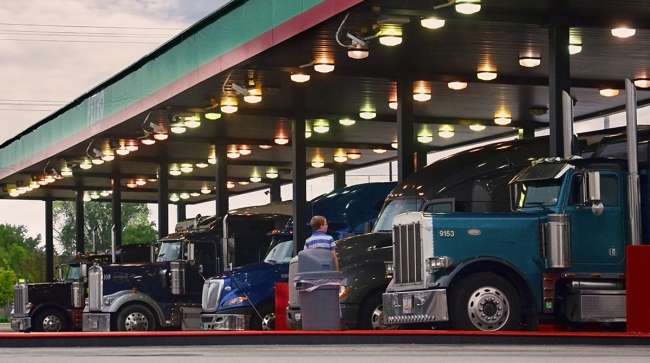Senior Reporter
Diesel Dips 0.4¢ to $2.922 a Gallon

The U.S. average retail price of diesel dipped 0.4 cent to $2.922 a gallon amid slipping oil prices as domestic and foreign producers squared off over how to manage production.
Diesel costs 44.2 cents more than it did a year ago, when it was $2.480 a gallon, the Department of Energy said Dec. 4.
Average prices for trucking’s main fuel fell in all regions except in New England and the Gulf Coast, where they rose 1.6 cents and 0.1 cent, respectively, and in the Lower Atlantic, where they were unchanged.
The U.S. average price for regular gasoline fell 3.3 cents to $2.50 a gallon. Gasoline costs 29.2 cents more than it did a year ago, DOE’s Energy Information Administration said.
Prices fell in all regions, as they did the previous week, when the average price declined 3.3 cents.
One trucking executive at a family run truckload carrier said a strong partnership with a truck dealership that delves into what best serves the customer is crucial to achieving maximum fuel efficiency.
That commitment includes transmissions pared correctly with the powertrain, rear axle ratio configurations such as 6X2s, wide-base tires versus duals, automated tire inflation systems (not just tire-monitoring devices) and aerodynamic enhancements both from the OEM and aftermarket, Jarit Cornelius, vice president of asset maintenance and compliance at Sharp Transport Inc., told Transport Topics.
“These are all factors in the fuel game,” Cornelius said. “When it comes to dealerships, we can go out and buy trucks or trailers from anybody. What we are looking for is somebody who truly wants to have us as a partner and who takes the time consistently to understand what our objectives are,” Cornelius said.
Sharp, which is based in Ethridge, Tenn., operates 125 Class 8 trucks that used about 1.3 million gallons of ultra-low-sulfur diesel in 2016 in its truckload division.
“With these [new] engines and transmissions, you have to try and fine tune the parameter sections to find what works for your application, including predictive cruise, foot and cruise speeds, shift patterns, how much idle time you allow or do you go with auxiliary power units,” he said.
Also, one of the most important factors is driver training.
“Unless your driver force understands what the technology is there for, and how to operate it efficiently, you’re just wasting money,” Cornelius said.
In two separate tests, Sharp achieved nearly 10 miles per gallon using the C 10 equipment package from the dealership Cumberland International plus in-cab driver coaching available through telematics, he said. “And we continue to push that 10 mpg envelope.”
Meanwhile, products supplied, an indication of demand, showed distillate fuel — primarily ultra-low-sulfur diesel used in transportation and to a lesser degree as heating oil — fell in the week ending Dec. 1 to 3.9 millions barrels a day compared with 4.1 million a week earlier. Distillate inventories increased by 1.7 million barrels, EIA reported.
Gasoline demand fell to 9 million barrels a day compared with 9.2 million a week earlier. Also, total motor gasoline inventories increased by 6.8 million barrels — which sent oil prices lower later in the week amid speculation refineries may not need as much crude going forward.
West Texas Intermediate crude futures on the New York Mercantile Exchange closed at $57.47 on Dec. 4, compared with $58.11 on Nov. 27.
The producers will maintain cuts until global supply meets demand, Saudi Arabia’s Energy Minister Khalid Al-Falih said. The Organization of Petroleum Exporting Countries’ output in November dropped to a six-month low, according to a Bloomberg News survey of analysts, oil companies and ship-tracking data.
“I don’t like $27 oil, but I don’t like $80 oil, either,” Gary Packer, chief operating officer for Newfield Exploration Co., said in an interview with Bloomberg. “Inefficiencies get bred into this industry at high commodity prices, and I think we have built efficiencies within the unconventional space [shale] to deliver exciting returns for our shareholders in a $50 environment.”
The weekly U.S. rig count was 929 during the week of Dec. 1, six rigs more than the week before and 332 more than a year earlier, oil-field services company Baker Hughes Inc. reported.
Houston-based Baker Hughes ranks No. 15 on the TT100 list of the largest private carriers in North America.




